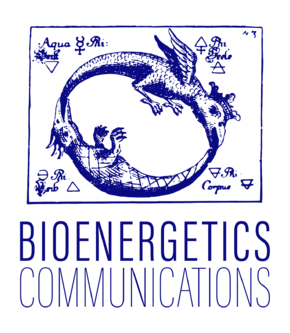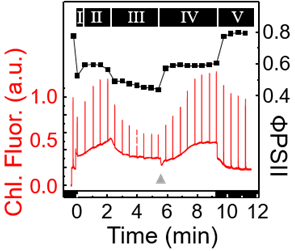| Roach T (2022) Chlorophyll fluorescence of Chlamydomonas reinhardtii: insights into the complexities. Bioenerg Commun 2022.10 https://doi.org/10.26124/bec:2022-0010 |
» Bioenerg Commun 2022.10. ![]()
published online 2022-11-10
Roach Thomas (2022) Bioenerg Commun
Abstract: ![]() https://doi.org/10.26124/bec:2022-0010
https://doi.org/10.26124/bec:2022-0010
Tolerance of rapid changes in light intensity by photosynthetic organisms is facilitated by non-photochemical quenching (NPQ), a term with reference to quenching of chlorophyll fluorescence, the technique used in its discovery. Mechanisms of NPQ include dissipating excess light energy to heat (qE), the reversible attachment of light-harvesting complexes (LHC) to photosystems (state transitions, qT) and photoinhibition (qI). Chlorophyll is a ubiquitous pigment of photosynthetic organisms, found in LHC and the reaction centers of photosystem II and I (PSII; PSI). At room temperature, pulse-amplitude modulated (PAM) chlorophyll fluorescence protocols provide insights into PSII efficiency, thus a reasonable proxy for photosynthetic activity and CO2 fixation. NPQ has a major impact on chlorophyll fluorescence intensity and is also quantified by PAM. Since NPQ mechanisms can occur simultaneously, they cause complexities in deciphering the signal. In algae, the ability for chlorophyll fluorescence in determining photosynthetic rates is not perfect, but it can still provide valuable information of processes affecting light harvesting. The aim of this report is to provide an overview of how various NPQ mechanisms in the model unicellular chlorophyte alga, Chlamydomonas reinhardtii, as well as environmental conditions, affect chlorophyll fluorescence. I also propose a PAM protocol enabling the kinetics associated with individual NPQ phases to be quantified in <20 min.
• Keywords: Chlorophyll fluorescence; photosynthesis; light stress; actinic light; NPQ; ROS; Chlamydomonas reinhardtii • Bioblast editor: Tindle-Solomon L
Preprint
Labels: MiParea: Instruments;methods
Organism: Algae
Preparation: Intact cells
Chlamydomonas, Photosynthesis, BEC





